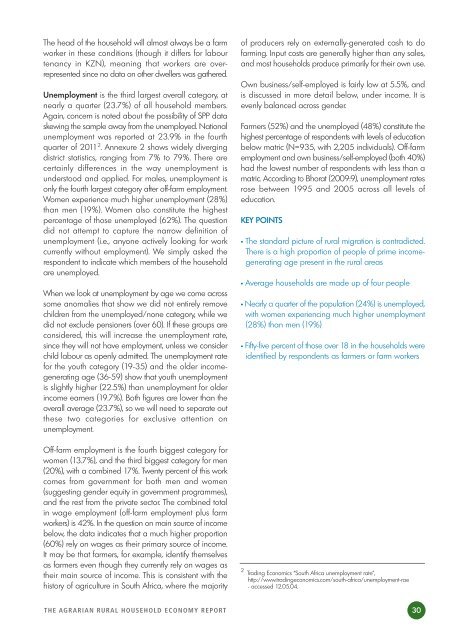THE AGRARIAN RURAL HOUSEHOLD ECONOMY
THE AGRARIAN RURAL HOUSEHOLD ECONOMY
THE AGRARIAN RURAL HOUSEHOLD ECONOMY
You also want an ePaper? Increase the reach of your titles
YUMPU automatically turns print PDFs into web optimized ePapers that Google loves.
The head of the household will almost always be a farm<br />
worker in these conditions (though it differs for labour<br />
tenancy in KZN), meaning that workers are overrepresented<br />
since no data on other dwellers was gathered.<br />
Unemployment is the third largest overall category, at<br />
nearly a quarter (23.7%) of all household members.<br />
Again, concern is noted about the possibility of SPP data<br />
skewing the sample away from the unemployed. National<br />
unemployment was reported at 23.9% in the fourth<br />
quarter of 2011 2 . Annexure 2 shows widely diverging<br />
district statistics, ranging from 7% to 79%. There are<br />
certainly differences in the way unemployment is<br />
understood and applied. For males, unemployment is<br />
only the fourth largest category after off-farm employment.<br />
Women experience much higher unemployment (28%)<br />
than men (19%). Women also constitute the highest<br />
percentage of those unemployed (62%). The question<br />
did not attempt to capture the narrow definition of<br />
unemployment (i.e., anyone actively looking for work<br />
currently without employment). We simply asked the<br />
respondent to indicate which members of the household<br />
are unemployed.<br />
When we look at unemployment by age we come across<br />
some anomalies that show we did not entirely remove<br />
children from the unemployed/none category, while we<br />
did not exclude pensioners (over 60). If these groups are<br />
considered, this will increase the unemployment rate,<br />
since they will not have employment, unless we consider<br />
child labour as openly admitted. The unemployment rate<br />
for the youth category (19-35) and the older incomegenerating<br />
age (36-59) show that youth unemployment<br />
is slightly higher (22.5%) than unemployment for older<br />
income earners (19.7%). Both figures are lower than the<br />
overall average (23.7%), so we will need to separate out<br />
these two categories for exclusive attention on<br />
unemployment.<br />
Off-farm employment is the fourth biggest category for<br />
women (13.7%), and the third biggest category for men<br />
(20%), with a combined 17%. Twenty percent of this work<br />
comes from government for both men and women<br />
(suggesting gender equity in government programmes),<br />
and the rest from the private sector. The combined total<br />
in wage employment (off-farm employment plus farm<br />
workers) is 42%. In the question on main source of income<br />
below, the data indicates that a much higher proportion<br />
(60%) rely on wages as their primary source of income.<br />
It may be that farmers, for example, identify themselves<br />
as farmers even though they currently rely on wages as<br />
their main source of income. This is consistent with the<br />
history of agriculture in South Africa, where the majority<br />
<strong>THE</strong> <strong>AGRARIAN</strong> <strong>RURAL</strong> <strong>HOUSEHOLD</strong> <strong>ECONOMY</strong> REPORT<br />
of producers rely on externally-generated cash to do<br />
farming. Input costs are generally higher than any sales,<br />
and most households produce primarily for their own use.<br />
Own business/self-employed is fairly low at 5.5%, and<br />
is discussed in more detail below, under income. It is<br />
evenly balanced across gender.<br />
Farmers (52%) and the unemployed (48%) constitute the<br />
highest percentage of respondents with levels of education<br />
below matric (N=935, with 2,205 individuals). Off-farm<br />
employment and own business/self-employed (both 40%)<br />
had the lowest number of respondents with less than a<br />
matric. According to Bhorat (2009:9), unemployment rates<br />
rose between 1995 and 2005 across all levels of<br />
education.<br />
KEY POINTS<br />
• The standard picture of rural migration is contradicted.<br />
There is a high proportion of people of prime incomegenerating<br />
age present in the rural areas<br />
• Average households are made up of four people<br />
• Nearly a quarter of the population (24%) is unemployed,<br />
with women experiencing much higher unemployment<br />
(28%) than men (19%)<br />
• Fifty-five percent of those over 18 in the households were<br />
identified by respondents as farmers or farm workers<br />
2 Trading Economics “South Africa unemployment rate”,<br />
http://www.tradingeconomics.com/south-africa/unemployment-rae<br />
- accessed 12.05.04.<br />
30


